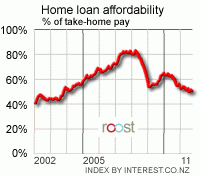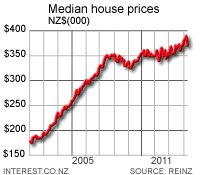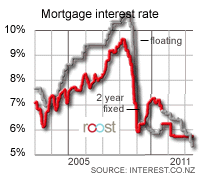
By Bernard Hickey
Home loan affordability improved in September to its best levels in 8 years, thanks to a drop in the national median house price and interest rates staying at record lows.
Economists expect the Reserve Bank to keep the Official Cash Rate at its record low level of 2.5% until well into 2012 because of an uncertain global economic outlook and a delayed start to the Christchurch earthquake rebuild. This would keep floating rates at their lows until then too.
“First home buyers are seeing very low interest rates and a stable outlook into early next year, which is improving confidence,” said Rhonda Maxwell, spokeswoman for mortgage broking group Roost Home Loans.
“Banks are also competing hard to boost their lending to property investors and first home buyers, who are increasingly withdrawing their KiwiSaver funds to use for deposits,” Maxwell said. KiwiSavers are able to withdraw their contributions to buy first homes after being in the scheme for three years.
Affordability improved nationally, but this disguised some deterioration in Central Auckland, North Shore, Central Wellington, Hutt Valley and Kapiti Coast because of a rise in median house prices, the Roost Home Loan Affordability report shows.
Lower house prices saw affordability improve in South Auckland, Porirua and Dunedin. Invercargill took back the title of the most affordable city in the country from Wanganui, while Queenstown is the least affordable for those on a median income. See the main report for links to regional reports.
 A young couple earning the median wage could afford to buy a first quartile priced house in August, with 20.6% of their disposable income required to service an 80% mortgage. This is down from 20.7% in August and is at its best levels since August 2004.
A young couple earning the median wage could afford to buy a first quartile priced house in August, with 20.6% of their disposable income required to service an 80% mortgage. This is down from 20.7% in August and is at its best levels since August 2004.The Roost Home Loan Affordability report measures affordability nationally and regionally for individual income earners and households, taking into account median house prices, interest rates and incomes in their regions and cities.
The Roost Home Loan Affordability measure for all of New Zealand showed the proportion of a single median after tax income needed to service an 80% mortgage on a median was 50.7% in September from 51.5% in August and is at its best level since September 2003. The worst level of affordability was 83.4% seen at the peak of the house price boom in March 2008 when 2 year mortgage rates were close to 10%.
Affordability has generally been improving since December 2009 as house prices have flattened out and interest rates have fallen.
More than 50% of home owners are now on floating mortgages and most new borrowers are choosing to float, given advertised floating rates at around 5.75% are cheaper than average longer term fixed rates at around 6.2%. The Home Loan Affordability reports use the floating rate.
Affordability is difficult in Auckland, Wellington, Christchurch, Hamilton and Tauranga for those on a single median income, but homebuyers in smaller provincial cities will find home ownership much more affordable. Households with two incomes are also in a stronger position, particularly those bidding for homes priced in the lower quartile.
 Affordability for households with more than one income improved in September because of the fall in median house prices. This measure of a ‘standard typical household' found the proportion of after tax income needed to service the mortgage on a median house fell to 33.5% from 34.0% at the end of August. It is down from a record high of 54% in November 2007.
Affordability for households with more than one income improved in September because of the fall in median house prices. This measure of a ‘standard typical household' found the proportion of after tax income needed to service the mortgage on a median house fell to 33.5% from 34.0% at the end of August. It is down from a record high of 54% in November 2007.This measure assumes one median male income; half a median female income aged 30-35 and a 5-year-old child that receives Working-for-Families benefits. Any level over 40% is considered unaffordable for a household, whereas any level closer to 30% has coincided with increased buyer demand in the past.
The first home buyer household measure assumes a first home buyer household includes a median male income and a median female income aged 25-29 with no children. Any level over 30% is considered unaffordable in the longer term for such a household, while any level closer to 20% is seen as attractive and coinciding with strong demand.
Full regional reports are available below:
- New Zealand (159kb .pdf)
- Northland (159kb .pdf)
- Whangarei (159kb .pdf)
- Auckland region (159kb .pdf)
- Auckland Central (159kb .pdf)
- Auckland North Shore (159kb .pdf)
- Auckland South(159kb .pdf)
- Auckland West(159kb .pdf)
- Waikato and Bay of Plenty (159kb .pdf)
- Hamilton (159kb .pdf)
- Tauranga (159kb .pdf)
- Rotorua (159kb .pdf)
- Hawkes Bay and Gisborne (159kb .pdf)
- Napier (159kb .pdf)
- Hastings (159kb .pdf)
- Gisborne (159kb .pdf)
- Taranaki (159kb .pdf)
- New Plymouth (159kb .pdf)
- Manawatu and Wanganui(159kb .pdf)
- Palmerston North(159kb .pdf)
- Wanganui(159kb .pdf)
- Wellington region (159kb .pdf)
- Wellington City (159kb .pdf)
- Wellington Hutt Valley(159kb .pdf)
- Porirua (159kb .pdf)
- Kapiti Coast (159kb .pdf)
- Nelson and Marlborough (159kb .pdf)
- Nelson (159kb .pdf)
- Canterbury (156kb .pdf)
- Christchurch (156kb .pdf)
- Timaru (156kb .pdf)
- Central Otago Lakes (159kb .pdf)
- Queenstown (159kb .pdf)
- Otago (159kb .pdf)
- Dunedin (159kb .pdf)
- Southland (159kb .pdf)
- Invercargill (159kb .pdf)
| Regional home loan affordability comparison: | ||||||
| mortgage payment as a % of weekly take-home pay | ||||||
|
Sep-11
|
Aug-11
|
Sep-10
|
Sep-09
|
Sep-08
|
Sep-07
|
|
| New Zealand |
50.7%
|
51.5%
|
57.1%
|
59.6%
|
71.1%
|
82.2%
|
| Northland |
46.4%
|
48.8%
|
54.4%
|
53.8%
|
70.3%
|
80.9%
|
| - Whangarei |
41.5%
|
40.1%
|
47.4%
|
47.5%
|
59.0%
|
70.3%
|
| Auckland |
65.3%
|
62.4%
|
69.7%
|
73.4%
|
84.9%
|
96.4%
|
| - Central |
69.3%
|
62.7%
|
79.9%
|
80.3%
|
88.1%
|
103.3%
|
| - North Shore |
69.5%
|
68.3%
|
77.4%
|
83.5%
|
91.7%
|
104.6%
|
| - South |
64.8%
|
66.3%
|
68.1%
|
74.3%
|
81.2%
|
100.7%
|
| - West |
55.0%
|
55.0%
|
62.2%
|
62.5%
|
74.9%
|
82.2%
|
| Waikato/BOP |
46.1%
|
49.2%
|
54.7%
|
57.4%
|
71.9%
|
79.8%
|
| - Hamilton |
52.0%
|
51.4%
|
60.2%
|
58.4%
|
73.5%
|
88.3%
|
| - Tauranga |
50.7%
|
57.0%
|
59.2%
|
67.0%
|
77.0%
|
89.5%
|
| - Rotorua |
39.1%
|
31.2%
|
40.6%
|
49.4%
|
57.6%
|
63.7%
|
| Hawkes Bay |
44.1%
|
40.8%
|
48.9%
|
51.0%
|
65.4%
|
74.6%
|
| - Napier |
49.8%
|
45.3%
|
54.9%
|
53.8%
|
66.2%
|
78.4%
|
| - Hastings |
40.2%
|
40.4%
|
48.4%
|
51.6%
|
60.1%
|
72.9%
|
| - Gisborne |
40.3%
|
41.3%
|
42.5%
|
54.6%
|
55.5%
|
69.9%
|
| Manawatu/Wanganui |
34.4%
|
34.5%
|
38.3%
|
41.8%
|
52.7%
|
61.5%
|
| - Palmerston North |
37.9%
|
39.2%
|
43.1%
|
50.5%
|
60.3%
|
67.1%
|
| - Wanganui |
32.7%
|
27.6%
|
34.6%
|
38.4%
|
42.8%
|
46.1%
|
| Taranaki |
40.8%
|
42.2%
|
47.7%
|
52.5%
|
60.1%
|
67.9%
|
| - New Plymouth |
46.1%
|
47.0%
|
54.0%
|
60.8%
|
65.2%
|
89.4%
|
| Wellington region |
50.8%
|
48.9%
|
60.1%
|
59.4%
|
69.7%
|
82.6%
|
| - City |
56.9%
|
54.9%
|
64.0%
|
68.4%
|
75.9%
|
88.5%
|
| - Hutt Valley |
46.0%
|
42.5%
|
57.5%
|
53.2%
|
60.5%
|
74.2%
|
| - Porirua |
56.2%
|
57.5%
|
61.9%
|
67.6%
|
72.6%
|
85.7%
|
| - Kapiti Coast |
50.6%
|
49.6%
|
58.2%
|
58.2%
|
63.8%
|
78.4%
|
| Nelson/Marlborough |
51.6%
|
50.8%
|
59.2%
|
63.6%
|
75.8%
|
84.6%
|
| - Nelson |
53.0%
|
49.9%
|
59.4%
|
65.1%
|
77.1%
|
82.9%
|
| Canterbury/Westland |
46.6%
|
48.7%
|
50.3%
|
54.9%
|
64.5%
|
76.7%
|
| - Christchurch |
52.8%
|
53.1%
|
57.8%
|
60.6%
|
70.0%
|
81.9%
|
| - Timaru |
38.6%
|
37.2%
|
37.4%
|
42.6%
|
60.0%
|
56.6%
|
| Central Otago Lakes |
60.3%
|
68.3%
|
82.5%
|
75.3%
|
111.8%
|
120.4%
|
| - Queenstown |
84.4%
|
77.7%
|
85.6%
|
85.9%
|
117.8%
|
144.1%
|
| Otago |
36.0%
|
37.9%
|
40.8%
|
44.1%
|
51.6%
|
59.5%
|
| - Dunedin |
41.0%
|
43.9%
|
46.1%
|
53.9%
|
56.0%
|
68.9%
|
| Southland |
26.2%
|
30.4%
|
32.1%
|
34.5%
|
43.9%
|
50.1%
|
| - Invercargill |
28.2%
|
33.5%
|
34.5%
|
37.4%
|
48.2%
|
53.4%
|
No chart with that title exists.
6 Comments
What is the best option for a new home buyer at the moment:
1. stay renting, keep substantial deposit in the bank (being eaten away with inflation)
2. buy a cheap house in a crappy suburb, that can easily be sustained by one income (debt being reduced with inflation),
3. buy an expensive house, that can only just be sustained on one income (more debt being eaten away by inflation)
It seems to me that having all your cash in savings at the moment is just as risky as having debt?
Is deflation at all likely?
I would say deflation is 90% certian now.....I expect houses to drop by 50% over 5 years maybe more so the Q is just when it starts in earnest. Its plain crazy out there in EU land....France wants Germany to help it keep its AAA rating, Germany doesnt want to pay or pay for the rest either....I cant see how that is resolved....its going to implode...bye bye EU.
I would suggest going for safety cash and cash like things.....once into deflation even 1 or 2% is good....and you dont pay tax on the money as its value improves....so have a look at the rules around deposit guarantees ie maybe split it between TSB and Kiwibank (I wouldnt go near a OZ bank), maybe Govn bonds....2 or 3 years.....
I suggest if its a decent sum asking a professional how to guarentee no capital losses....I wouldnt buy a house right now unless its 60% below GV....
regards
How do you come to the conclusion that House prices will drop by 50% ?
Even over the past 3 years Bricks, Glass, Plumbing, Electrical, Tin, Carpet, Timber and Wages, Regulatory Costs in the building sector have been increasing.
In fact not a single item for the construction of Housing has become less expensive over the last 5 years.
Are you expecting Builders to take a 50% wage cut, The council a 50% cut on Council Contributions? Cheaper fuel for materials to be trucked around?
Because if you can justify your comment we will stop building tonight and wait 5 years.
The selling price of a house is not determined by the cost of the materials that went into it, it is determined by what buyers are willing/able to pay.
If the willingness/ability of potential buyers to get huge mortgages goes away, the prices will follow.
Thanks steven, the only issue with the EU thing is that I've heard it before, when the USA was supposed to implode. That was supposed to affect everything over here, but so far has not had a dramatic effect.
Will this time be different?
The real world. Changing the social structure of our two biggest cities
[extract] Mainland Chinese are investing $3 billion a year in Sydney and Melbourne apartments. At the same time, locals are being priced out of the market. They might not yet realise it, but if local councils and the Reserve Bank continue with their current policies they will change the social structure of our two biggest cities. There is no doubt that without the Chinese buying apartment prices would fall to levels that would make it uneconomic to build apartments in inner suburban areas.
http://www.businessspectator.com.au/bs.nsf/Article/Harry-Triguboff-Chin…


We welcome your comments below. If you are not already registered, please register to comment.
Remember we welcome robust, respectful and insightful debate. We don't welcome abusive or defamatory comments and will de-register those repeatedly making such comments. Our current comment policy is here.